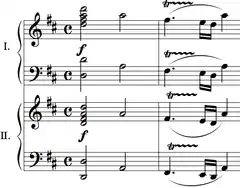Sonata for Two Pianos (Mozart)
The Sonata for Two Pianos in D major, K. 448 (375a), is a work composed by Wolfgang Amadeus Mozart in 1781, when he was 25. It is written in sonata-allegro form, with three movements. The sonata was composed for a performance he would give with fellow pianist Josepha Auernhammer.[1] Mozart composed this in the galant style, with interlocking melodies and simultaneous cadences. This is one of his few compositions written for two pianos.
| Sonata for Two Pianos | |
|---|---|
| by W. A. Mozart | |
 Beginning of the sonata | |
| Key | D major |
| Catalogue | K. 448 (375a) |
| Style | Classical period |
| Composed | 1781 |
| Movements | Three (Allegro con spirito, Andante, Molto allegro) |
Description
The sonata is written in three movements:
- Allegro con spirito, in D major and common time
- Andante, in G major and triple time
- Molto allegro, in D major and duple time
- Allegro con spirito
- The first movement sets the tonal center with a strong introduction. The two pianos divide the main melody for the exposition, and when the theme is presented, both play it simultaneously. Little time is spent in the development section; a new theme is introduced (unlike most sonata forms) before the recapitulation, repeating the first theme.
- Andante
- The second movement is written in ABA form.
- Molto allegro
- The third movement begins with a galloping theme. The cadences used in this movement are similar to those in Mozart's Rondo alla Turca.
Mozart effect
Mozart's K 448 was the composition used in the original study that led to the theory of the so-called Mozart effect, which posited that listening to the piano sonata improved spatial reasoning skills, later widened in pop-science to an increase in IQ in general.[2]
Notes
- Zaslaw, Neal, The Compleat Mozart: A Guide to the Musical Works, p. 301 (New York, 1990) ISBN 0-393-02886-0
- University of Vienna (May 10, 2010). "Mozart's music does not make you smarter, study finds". Science News. Retrieved October 3, 2021.
External links
- Sonate in D für Zwei Klaviere KV 448: Score and critical report (in German) in the Neue Mozart-Ausgabe
- Recording of Sonata for Two Pianos in D major by Sivan Silver and Gil Garburg (archived on the Wayback Machine)
- Sonata for Two Pianos, K.448/375a: Scores at the International Music Score Library Project
This article is issued from Wikipedia. The text is licensed under Creative Commons - Attribution - Sharealike. Additional terms may apply for the media files.